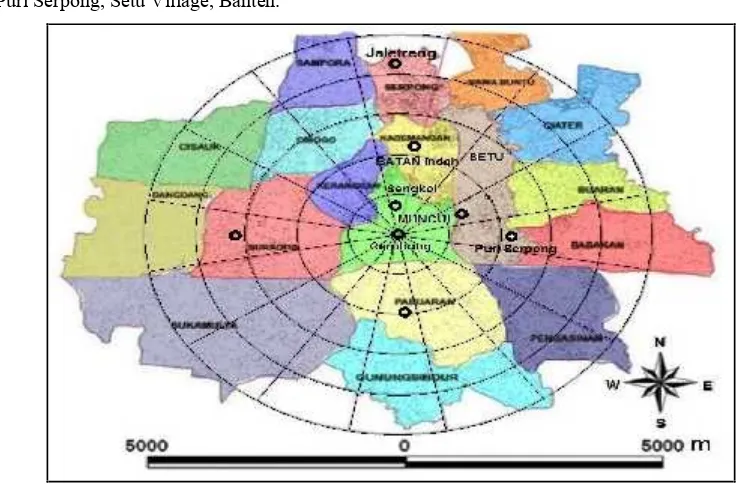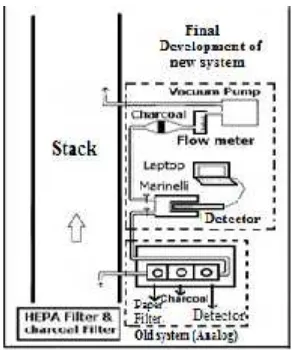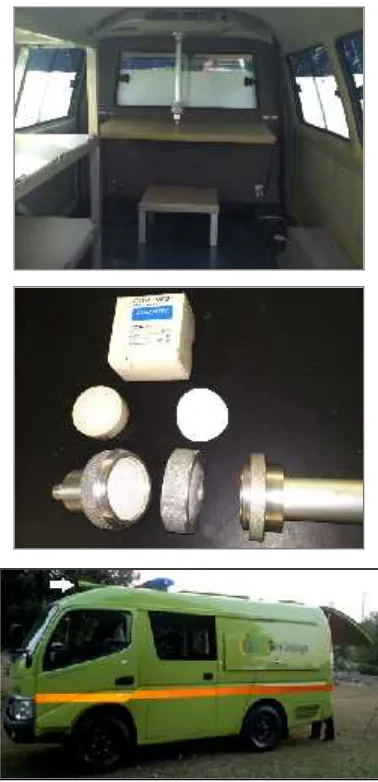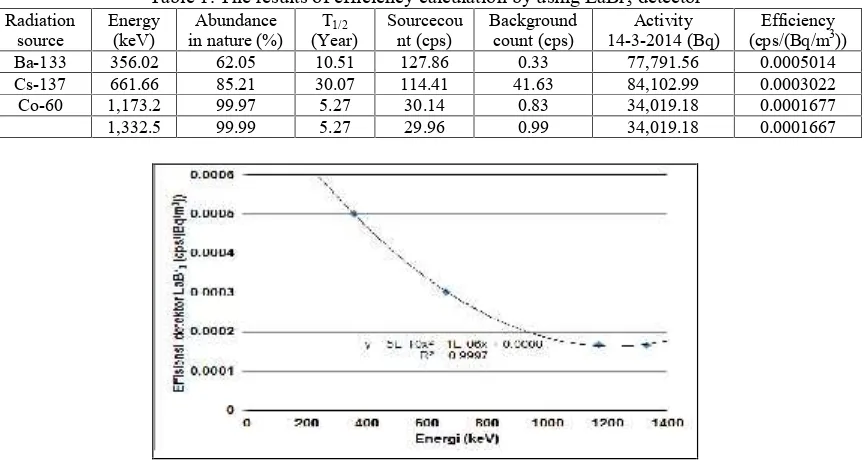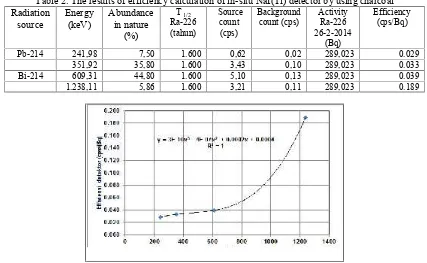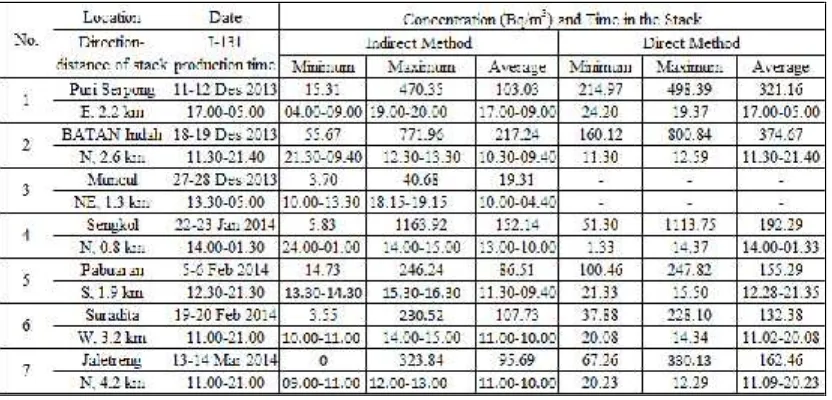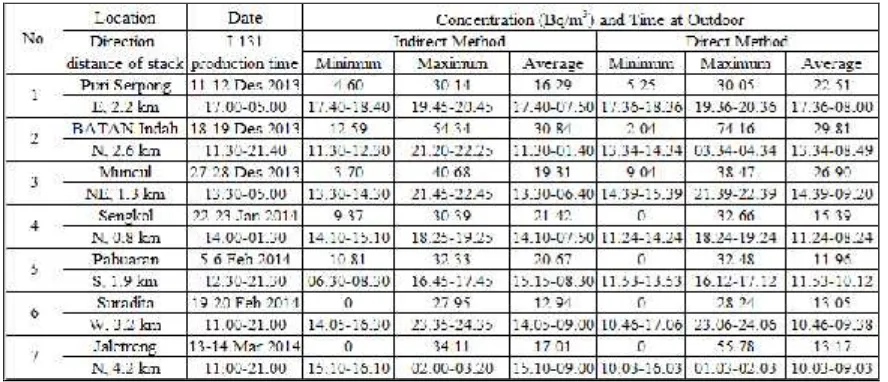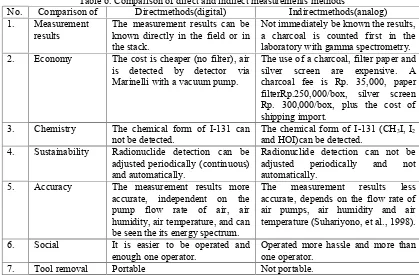Comparative Analysis of I-131 Concentration Measurement Methods By Direct
and Indirect From The Radioisotopes Production Stack to Outdoor
Gatot Suhariyono and Bunawas
Center for Technology of Radiation Safety and Metrology,National Nuclear Energy Agency of Indonesia Jalan Lebak Bulus Raya No. 49 Jakarta Selatan, 12440 Indonesia, E-mail : [email protected]
Abstract.The Radioisotopes Production Facility at PUSPIPTEK Serpong produces and processes I-131 that can disperse to the settlements (community) and the environment around the Serpong Nuclear Area (SNA). I-131 is produced routinely for medical purposes in hospitals and pharmacies, for both domestic and export. I-131 is a beta and gamma emitting radioactive material and can cause thyroid cancer. The problems are that there are so far no research and in-depth assessment of the air dispersion of a I-131 radioactivity emitted from the radioisotopes production stack to the environment at actual conditions. The research was conducted simultaneously measurement of I-131 radioactivity in the stack of the I-131 radioisotope production facility, Serpong and at houses courtyard (outdoor) of SNA based on the variations of the distance and wind direction in normal condition (no accident). Direct measurement is carried out with a portable in-situ NaI(Tl) detector at outdoor, and with a LaBr3detector in the stack. Indirect measurement is carried out by using the charcoal filter and vacuum
pump in the stack and outdoor. Direct measurement method has many advantages than indirect measurement. Direct measurement method is more accurate, less expensive economically, easier to operate socially, just need an operator on its implementation, portable, and sustainability can be operated continuously. The overall activity concentrations of I-131 on average either by direct or indirect method were still below the standard radioactivity levels of I-131 in the air (530 Bq/m3) based on rule of PERKA BAPETEN No. 7/2013.
Keywords:stack, Iodine-131, I-131, outdoor, charcoal, environment, in-situ, dispersion, direct, indirect.
Introduction
I-131 radionuclide is the largest of radionuclides released from a nuclear accident compared to other radionuclides. Therefore I-131 removable is to be anticipated in the event of a nuclear emergency. The experience from other countries, for example, the activity of the I-131 radionuclide released from the nuclear accident at the Oak Ridge laboratory (Tennesse) in 1944-1956 was as much as 0.30 to 1.55 PBq, Hanford (Washington) in 1944 to 1972 was 27.83 PBq (1 PBq = 1x1015 Bq), Nevada in 1952 to 1970 was as many as 5,550 PBq, Three Mile Island (Pennsylvania) in 1979 was 555-777 GBq (1 GBq = 1x109 Bq), Chernobyl (Russia) in 1986 was amounting to 1,850 PBq, Savannah River (South Carolina) in 1955-1990 was 2.22 PBq, and Fukushima (Japan) in March 2011 was 400 PBq (ATSDR, 2008; UNSCEAR 2013, 2014).
Radioiodine (I-131) is one of a radioactive substance that is big enough to get attention, because it is volatile with a probability of 81.21% of its formation greater than the other radioiodine (ATSDR, 2008). Human organs are critically affected by I-131
Radioisotope production facility is located in the Pusat Penelitian Ilmu Pengetahuan dan Teknologi (PUSPIPTEK), Serpong. This facility produces some radioisotopes, one of which is the production of I-131
was routinely produced for medical purposes in hospitals and pharmacies, both domestic and export. This facility is located in Serpong Nuclear Area Agency) and BAPETEN (Nuclear Energy Regulatory Agency) to conduct research on the radionuclide removable of radiation protection, and in particular Iodine-131 (I-131) from stack in the radiation facilities into the environment. Therefore, it is necessary to research and study the concentration of I-131 release from the stack to the settlements around the SNA based on the variation of the distance and direction of wind by using direct and indirect methods simultaneously. Direct measurements by using a portable detector of NaI (Tl) in-situ were performed at outdoor and by using the LaBr3detectors in the stack. Indirect measurements by using a charcoal filter and vacuum pump were performed in the stack and at outdoor. Quality standard value of I-131 radioactivity levels in the air is 530 Bq/m3 based on rules of PERKA BAPETEN No. 7/2013.
Materials And Methods
radioactive from the stack (Figure 1). The research locations are in:
1. North of the stack: 825 m, Sengkol, Muncul Village, Banten.
2. North of the stack: 2.6 km, Housing Complex of BATAN Indah, KademanganVillage, Banten. 3. North of the stack: 4.2 km, Jaletreng, Serpong
Village, Banten.
4. East of the stack: 2.2 km, Housing complex of Puri Serpong, Setu Village, Banten.
5. North East of the stack: 1.3 km, Muncul, Setu Village, Banten.
6. South of the stack: 1.9 km, Pabuaran Village, Bogor, West Java.
7. West of the stack: 3.2 km
,
Housing Complex of Griya Serpong Asri, Suradita Village, Banten.Figure 1. Research location at Serpong Nuclear Area (SNA)
Monitor Calibration of Radioactive Gas
Measurement of I-131 radioactive gas was conducted by using direct and indirect methods. Direct method is conducted by direct measurement of the I-131 air concentration from the stack with a scintillation detector of LaBr3(Lanthanum Bromide). The indirect method is performed by using activated charcoal filter (charcoal) (Hinds, 1982). The concentration of I-131 adsorbed in the charcoal was detected by scintillation detector of NaI (Tl) in a research laboratory.
Calibration of LaBr3 scintillation detector is conducted by counting three radiation standard sources i.e. Ba-133, Cs-137 and Co-60. Activity of Ba-133 on December 2, 2013 was 79.238 kBq. Activities Cs-137 and Co-60 on 1 April 2000 respectively is 116 kBq and 213 kBq. Source Ba-133 with a half-life of 10.51 years has gamma energy that much, but the greatest abundance in nature is 62.05% at energy 356.017 keV. Source of Cs-137 with a half-life of 30.07 years have only one gamma energy with natural abundance of 85.21% at energy 661.660 keV. Source Co-60 with a half-year 5.271 has two energy-keV gamma 1173.237 and 1332.501 energy-keV with abundance in nature, each for 99.97% and 99.99%.
Calibration of NaI(Tl) scintillation detector that used for counting charcoal in a stackis conducted with chopping radiation standard source of Ra-226 in the form of charcoal. Activity of Ra-226 on 1 September 1993, at 12.00, is 291.6 Bq. Standard source of Ra-226 has a half-life of 1,600 years. Abundance of Ra-226 on gamma energy (186.101 keV) is low (3.5%). Gamma energy efficiency of Ra-226 that is used for calibration is taken from progeny of Ra-226 i.e. Pb-214 and Bi-214. Energy of Pb-214 is 241.982 and 351.922 keV with a natural abundance in respective 7.5 and 35.8%. Energy of Bi-214 is 609.313 and 1238.11 keV with abundance in nature respectively 44.8 and 5.86%.
Counting efficiency of LaBr3 detector is calculated using the following equation:
(1)
In this case, is the count efficiency of detector calibration (cps/(Bq/m3). A is the activity of standard radiation source (Bq). Nt is the count of I-131 in the detector (cps). NBgis the count of background without I-131 (cps). t is the length of count time(s). F is the flow rate of vacuum pump air in the stack (m3/s). Y is an abundance of radiation standard sources in nature (%).
The counting efficiency of NaI(Tl) detector is used to measure the activity of I-131 in charcoal that is calculated by the following equation:
(2)
The efficiency unit () of equation (2) is cps/Bq. The flow rate in equation (2) does not exist, because the flow rate that is used in the studies is different. The flow rates of the vacuum pump are from the pump for the direct method with LaBr3detector in the stack and the pump with detector NaI (Tl) in-situ in the survey car is 20.65 lpm (3.44 x 10-4m3/s) and 25 lpm (4.17x10-4m3/s) respectively. The counting efficiency of I-131 at 364.48 keV gamma energy was obtained from the graph of count efficiency on standard sources as a function on several energies of standard sources.
Measurement Method of I-131 Concentration Measurement Method of I-131 concentration in the stack
Methods of radioactivity measurement in the stackof radioisotop production in this study were developed a monitoring system of air portable and can be monitored directly continuously every time. Excess of air monitoring system by using a scintillation detector of LaBr3 (Lanthanum Bromide) is portable, no need the nitrogen gas and is connected to a laptop computer directly, so that the radioactive air that is released into the environment can be monitored the count rate per unit of time periodically. Measurement of flow rate is by using a digital flow rate, so that the air flow rate that is sampled can be monitored on a laptop continuously. Excess of a scintillation detector of LaBr3that is compared with scintillation detector of NaI (Tl) in-situ is LaBr3detector resolution better than the resolution of NaI (Tl), so that radionuclides detection by using the LaBr3detector is more accurate.
Air monitoring system in the stack is shown in Figure 2. The air containing I-131 that is coming from the stackis adsorbed by the vacuum pump and then air passes to Marinelli and is forwarded to charcoal and to flowmeter. Air that is entering to Marinelli is detected the content of I-131 by using a LaBr3detector. Results of I-131 countare read every 10 minutes directly in the form of the spectrum energy at 364 keV.
Sampling and measurement of radioactive I-131 gas in the stack was conducted by two methods i.e. direct and indirect methods. Direct method was conducted with direct sampling and measurement of the air concentration containing I-131 from the stack by using a scintillation detector of LaBr3(Lanthanum Bromide) every 10 minutes continuously. The indirect method was conducted with I-131 sampling by using activated charcoal filter every 1 hour for 12 times. Measurement of I-131 radionuclide in charcoal samples was conducted by using gamma spectrometer system and a detector of NaI(Tl) in-situ for an hour. The results of these two measurements both direct and indirect methods of I-131 counts that is obtained per efficiency from calibrating the NaI(Tl) detector (cps/Bq), Ntis the count of I-131 on charcoal (indirect method, in counts), NBg is the count of background without I-131 (counts), t is the length of count time (s), ts is the sampling time (s), F is the flow rate of sampling (m3/s), Y is an abundance of I-131 in nature (81.21%).
Figure 2. Measurement system of I-131 in the stack
detector. The activity rate of removable air containing I-131 from the stack for 1 year (Ct) is calculated with using the equation (Sumarno, Y., et. al., 2008):
Ct=C.V.T (Bq/year) (5)
V is the average flow rate of airborne in the stack (1.699.105 m3/h). T is the maximum length of operation time per year (h/year).
If activity rate is calculated in unit of Bq/h from the equation (5), so that activity rate is calculated without the variable of T (h/year). Operation of I-131 radioisotope production between 8 to 12 hours. Production of I-131 radioisotopes for one year is usually between 30 to 40 times a year. T Variable is taken the maximum value of the operations of radio isotopes production is 480 hours/year. Based on SK Ketua Komisi Proteksi Radiasi in SNA, No. 01/KNS/III/2011, release limit of I-131 radionuclide into the atmosphere in the SNA is 3.19.108 Bq/week (1.90.106 Bq/h). Value of standard quality levels of radioactivity in the air is 530 Bq/m3 based on the regulation of PERKA BAPETEN No. 7/2013.
Measurement Method of I-131 concentration at outdoor
Measurement of the I-131 concentration at outdoor is conducted with observe to the location of the open and away from buildings and trees. Measurement of I-131 in the air is conducted in twomethods i.e. direct measurement method and indirect method. Indirect method of the I-131 concentration in the air is used by BATAN frequent every three months periodically. Filter paper and charcoal is used as a means of I-131 gas sampling in the indirect method. Sampling tool is placed ± 2.5 m above the ground by using Isokinetic probe on the environment survey car and overlooking to the stack as a source of air release(Figure 3). Sampling tool of I-131 is regulated by a vacuum pump at a flow rate of 25 lpm and turned on for one hour. The filter that after used of sampling for 1 hour is replaced by another charcoal filter until production operations of I-131 in the stack finished. Filter paper and charcoal are counted by using detector of NaI (Tl) in-situ.
Measurement method of the I-131 concentration in the air directly is shown in Figure 4. The method of direct measurement of I-131 at outdoor is conducted above on the car of environment survey. Measurement of I-131 at outdoor air is conducted directly by using detector of NaI(Tl) in-situ portable and attached to the top of the car. On the measurement of I-131 in the outdoor air, the position detector is facing upwards. In the vicinity of the detector is installed the protective of Pb, so that only the I-131 radionuclide is coming from above or from below detectable. This detector is connected to the laptop directly, so that the spectrum
of I-131 can be detected on the energy of 364 keV directly. The concentration of I-131 in the air that is measured by the indirect method is calculated based on the equation (3). If it is measured by the direct method, so that it is calculated by equation (4).
Figure3. Air sampling system with indirect method by using charcoal.
Results and Discussion
Calibration of LaBr3detektor
Scintillation detector of LaBr3 is calibrated by counting three radiation standard sources i.e. Ba-133, Cs-137 and Co-60. The calibration results are shown in Table 1 and Figure 5. Calculation of efficiency is used on equation (1). The flow rate of the air sampling from vacuum pump in the stack is 20.65 lpm (3.44.
10-4m3/s). The calculation results of efficiency is made graph against energy (keV). Efficiency of the detector (y) on the energy of I-131 (x = 364.48 keV) is obtained from the calculation of the equation y = 5. 10-10x2-1.10-06x+8.10-4i.e. 0.0004919 cps/(Bq/m3). This value of efficiency is used to calculate the activity concentration (Bq/m3) on equation (4).
Table 1. The results of efficiency calculation by using LaBr3detector
Radiation
Ba-133 356.02 62.05 10.51 127.86 0.33 77,791.56 0.0005014
Cs-137 661.66 85.21 30.07 114.41 41.63 84,102.99 0.0003022
Co-60 1,173.2 99.97 5.27 30.14 0.83 34,019.18 0.0001677
1,332.5 99.99 5.27 29.96 0.99 34,019.18 0.0001667
Figure 5. LaBr3detector efficiency as a function of radiation source energy
Scintillation Detector Calibration of NaI (Tl) in-situ to measure I-131 in charcoal
Detector of NaI (Tl) in-situ is calibrated by using Ra-226 standard source in charcoal. The results of the detector calibration of NaI (Tl) in-situ on I-131 samples in the charcoal are displayed on Table 2 and Figure 6. The calculation of the detector efficiency of NaI (Tl) in-situ is usedon equation (2). The calculation results of efficiency is made graph against energy (keV). Efficiency of the detector (y) on the energy of I-131 (x=364.48 keV) is obtained from the calculation of the equationy = 3.10-10x3- 4.10-7x2+ 2.10-4x+4.10-4 i.e. 0.035 cps/Bq. Activity concentration (Bq/m3) of I-131 in the charcoal can be calculated by equation (3).
Concentration of I-131 activity at the stack
Measurement of the I-131 activity concentration was carried out in the stack and at the outdoor near the Muncul Junction together on December 27thand 28th, 2013. The production process of I-131 on those dates began around 13:30 to 05:00. Around 16:00 to 18:00 and 21:00 to 23:00 the termination process of the production of radioisotopes, because of the broken instrument.
Table 2. The results of efficiency calculation of in-situ NaI(Tl) detector by using charcoal Radiation
source
Energy (keV)
Abundance in nature
(%)
T1/2
Ra-226 (tahun)
Source count
(cps)
Background count (cps)
Activity Ra-226 26-2-2014
(Bq)
Efficiency (cps/Bq)
Pb-214 241,98 7,50 1.600 0,62 0,02 289,023 0.029
351,92 35,80 1.600 3,43 0,10 289,023 0.033
Bi-214 609,31 44,80 1.600 5,10 0,13 289,023 0.039
1.238,11 5,86 1.600 3,21 0,11 289,023 0.189
Figure 6. Efficiency of in-situ NaI (Tl) detector on charcoal as a function of radiation source energy
Figure 7. Activity concentration of I-131 by using the indirect method on 11– 12 December 2013
Figure 8. Activity concentration of I-131 by using the direct method on 11 – 12 December 2013
The measurement results of I-131 activity concentration as a whole with direct and indirect methods in the stack is shown in Table 4. Concentra-tions of the I-131 activity from the indirect measurement system on December 27thand 28th, 2013 were including low, if it were compared to the values of the I-131 activity concentration in the stack on the
I-131 activity concentration was highest average in the stack on December 18th to 19th,2013 with the indirect method, i.e.217.24 Bq/m3. I-131 activity concentration was highest average in the stack on December 18thto 19th, 2013 of the direct method was 374.67 Bq/m3. Measurement of the I-131 activity concentration in the stack on December 18th to 19th, 2013, along with measurement of I-131 activity
concentration in BATAN Indah housing. Overall activity concentration of I-131 on average either by direct or indirect method was still below the quality standard I-131 radioactivity levels in the air i.e. 530 Bq/m3based on regulation of PERKA BAPETEN No. 7/2013.
Table 4. The results of I-131 concentration measurements in stack
Concentration of I-131 Activity at Outdoor
The measurementresults of I-131 activity concentration in outdoor, housing complex of Puri Serpong, on December 11thand 12th, 2013, by using the indirect and direct methods are shown on Figure 9 and Figure 10 respectively. The concentration of I-131 activity that highest at outdoor measured by the indirect method was almost same compared with the highest concentration of I-131 with direct measure-ment method respectively i.e. 30.14 Bq/m3on 19:45 to 20:45 and 30.05 Bq/m3on 19:36 to 20:36. Most of the total concentration was 56% derived from organic iodine concentration in the form of methyl iodide (CH3I), 25% in HOI and 19% in I2. The highest concentration of I-131 activity by using the indirect method on 19:45 to 20:45 was coincided with the highest concentration of I-131 by using direct measurement methods on 19:36 to 20:36. The decline in activity concentrations of I-131 occurred at the same time both methods directly on 22:36 to 23:36 and indirectly on 22:10 to 23:10. This decrease is due to the wind speed that is high at approximately 3.1 m/s on these hours.
The measurement results of I-131 concentration as a whole in the outdoor SNA settlement by using the direct and indirect methods respectively is shown on Table 5. The highest average concentration of I-131 of seven research sites was located in BATAN Indah housing, both at outdoor by using direct (29.81 Bq/m3) and indirect (30.84 Bq/m3) methods. The maximum
Figure 9. I-131 activity concentration in outdoor of Puri Serpong housing by using indirect method
Figure 10. I-131 activity concentration in outdoor of Puri Serpong housing by using direct method
Table 5. The results of I-131 concentration measurements in the outdoor of the SNA settlement
The measurement comparison of direct (digital) and indirect (charcoal) are shown on Table 6. The comparison proves that the direct measurement method to have the advantage of more than an indirect measurement method. The measurement system of radioactive releases in the stack of nuclear facilities by using direct methods can be used to replace the old indirect system of radioactive measurement (charcoal), because the system of measurement direct method is more accurate, cheaper economically, easier to operate socially, just one operator in its
implementation, portable, and can be operated continuously sustainability.
Conclusions
and in the outdoor, surrounding of Serpong Nuclear Area (SNA), was still below the quality standard of I-131 radioactivity levels in the air i.e. 530 Bq/m3 based on regulation of PERKA BAPETEN No. 7/2013. Dispersion of I-131 from the stack was average heading into settlements which is located in
the north of the stack. I-131 concentration formed a parabolic curve to the north of the stack, start to rise from the Sengkol settlement (0.8 km of stack), the highest in BATAN Indah (2.6 km of stack) and the decline to Jaletreng (4.2 km of stack).
Table 6. Comparison of direct and indirect measurements methods
No. Comparison of Directmethods(digital) Indirectmethods(analog) 1. Measurement
results
The measurement results can be known directly in the field or in the stack.
Not immediately be known the results, a charcoal is counted first in the laboratory with gamma spectrometry. 2. Economy The cost is cheaper (no filter), air
is detected by detector via Marinelli with a vacuum pump.
The use of a charcoal, filter paper and silver screen are expensive. A charcoal fee is Rp. 35,000, paper
4. Sustainability Radionuclide detection can be adjusted periodically (continuous) and automatically.
Radionuclide detection can not be adjusted periodically and not automatically.
5. Accuracy The measurement results more accurate, independent on the pump flow rate of air, air humidity, air temperature, and can be seen the its energy spectrum.
The measurement results less accurate, depends on the flow rate of
7. Tool removal Portable Not portable.
Acknowledgements
Thanks very much to Dr. Ir. Yudi Utomo Imardjoko (Head of radioisotope production facility in Serpong, Indonesia), Dr. Ing. Kusnanto and Abdurrahman Dzikri in Serpong who have allowed and assist this research in the stack. Thanks to the Minister of Research and Technology that has provided this research grants. Thanks to Prof. Haryoto Kusnoputranto (UI), Prof. Kardono (BPPT), and Dr. Syahrir (BAPETEN) which supported this research to be successful.
References
ATSDR. (2008). Case studies in environmental medicine: Radiation exposure from Iodine-131.Agency for Toxic Substances and Disease Registry (ATSDR). US Department of Health and Human Services.
Baker, A. (2007). Air-sea exchange of Iodine. School of Environmental Sciences, University of East Anglia, Norwich, UK, http://www.uea.ac.uk/~e780/airseaiod. htm. 20 Mei 2011, pk. 22.15 WIB.
BPS-BATAN (2012).Pemutakhiran rona lingkungan kawasan nuklir Serpong, Badan Pusat Statistik (BPS) Kabupaten Tangerang dan Pusat Teknologi Limbah Radioaktif-BATAN.
Hinds, W. C. (1982). Filtration, Aerosol Technology. New York: John Wiley and Sons Inc.
Sumarno, Y., Hartoyo, U., & Fahmi, A. M. (2008).Analisis konsentrasi I-131 lepasan udara cerobong di Reaktor Serba Guna G. A. Siwabessy. Prosiding Seminar Nasional IV SDM Teknologi Nuklir. ISSN 1978-0176. Yogyakarta.
Suhariyono, G., Bunawas, & Wiyono, M. (1998, Mei 26-28).Effisiensi adsorbsi I-131 pada f i l t e r arang aktif terhadap fungsi suhu, laju alir, dan kelembaban udara. Seminar Ilmiah Penelitian Dasar Ilmu Pengetahuan dan Teknologi Nuklir. PPNY – BATAN. Yogyakarta. UNSCEAR 2013. (2014). Sources, Effects and Risks of
Ionizing Radiation: Levels and effects of radiation exposure due to the nuclear accident after the 2011 great East-Japan earthquake and tsunami. Scientific Annex A. United Nations Scientific Committee on the Effects of Atomic Radiation. Volume 1. Report to General Assembly. New York: United Nations Publication.
Discussion
Q : Dr. Andreas Bollhöfer (BfS, Germany)
1. How is the process of measuring the I-131 in the stack?
2. How is Xenon measurement method by using charcoal?
A : Gatot Suhariyono
1. Measurement of radioactive I-131 gas in the stack was conducted by two methods i.e. direct and indirect methods. Direct method was conducted with direct sampling and measurement of the air concentration containing I-131 from the stack by using a scintillation detector of LaBr3(Lanthanum Bromide) every 10 minutes continuously. The indirect method was conducted with I-131 sampling by using activated charcoal filter every 1 hour for 12 times. Measurement of I-131 radionuclide in charcoal samples was conducted by using gamma spectrometer system and a detector of NaI(Tl) in-situ for an hour. Air monitoring system in the stack is shown with detail in Figure 2. 2. Writer does not measure Xenon by using charcoal
